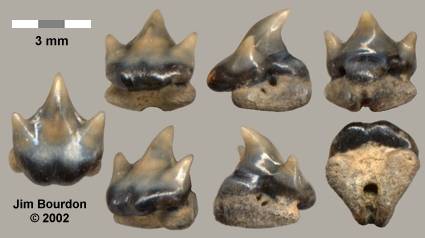| |
This genus was erected for teeth that had previously been included in
Ginglymostoma,
but which showed a number of morphological differences
from other teeth ascribed to this genus. Noubhani & Cappetta (1997)
deemed relevant:
1) Laterally compressed and labio-lingually elongated teeth in all file
positions (relative to other members of the genus).
2) Low number of lateral cusplets (not exceeding two pairs)
3) A strong medio-vertical crest on the labial face of the cusp.
A single species is attributed to this genus - Delpitoscyllium
africanum (LERICHE 1927). Teeth of this species
have been reported from the Palaeocene (Danian & Thanetian) of western
Africa (Morocco, Cabinda, Zaire) and the Palaeocene (Selandian) and Eocene
(Ypresian) of eastern North America (Maryland and Virginia).
In defining the genus, the authors noted that the teeth are longer
than broad with a triangular cusp and a pair (2nd pair in lateral
positions) of divergent lateral cusplets. The cusplets develop low
on the crown face but project relatively high. The apron is long and
broadly rounded in anterior files and slightly bifid
in lateral files. The strongly projecting medio-lingual protuberance
of the crown does not fully cover the root. The root is rather high,
labio-lingually elongated with a heart-shaped outline
and weakly convex basal face. The central foramen is broad &
elliptical and located lingually in the nutrient groove. Small
margino-lingual foramina are also present.
 |
Fig. 1 — Delpitoscyllium africanum
Piscataway Mbr, Aquia Frm (Late Palaeocene)
(from collection of Bill Heim) |
 |
Fig. 2 — Delpitoscyllium africanum
Nanjemoy Formation (Eocene)
width 3.5, 3.3, 4.0 mm
(from collection of Mike Folmer)
|
|